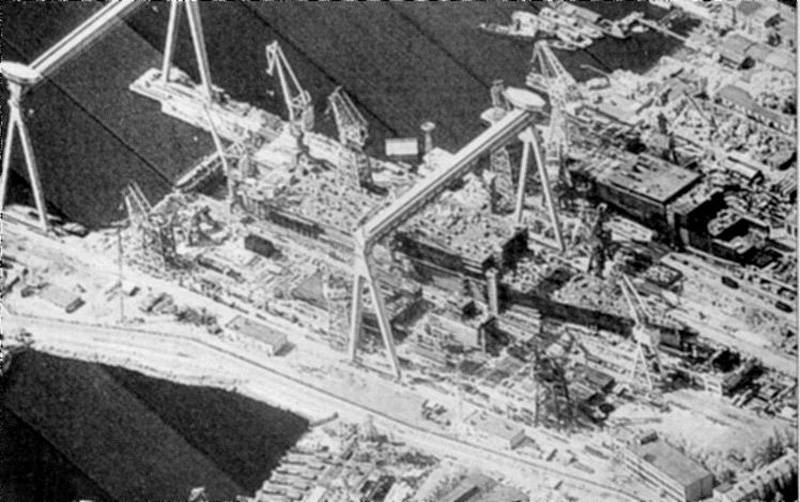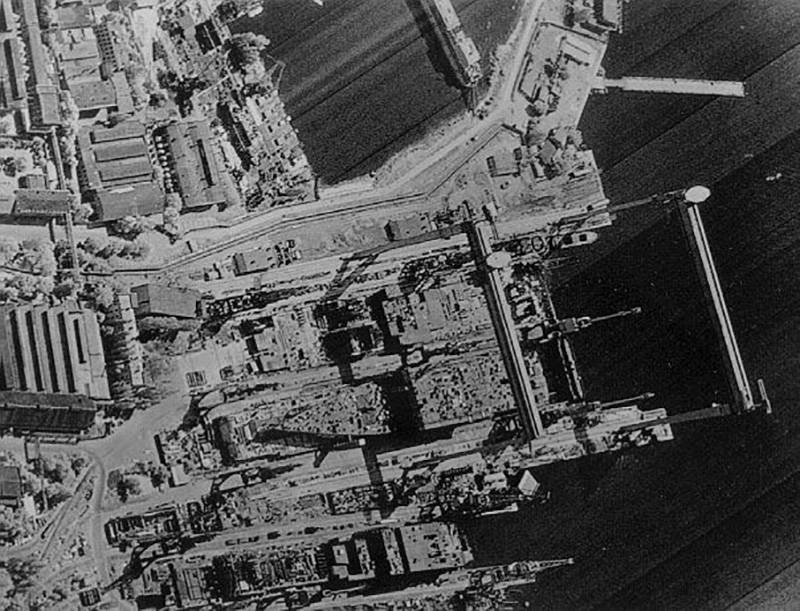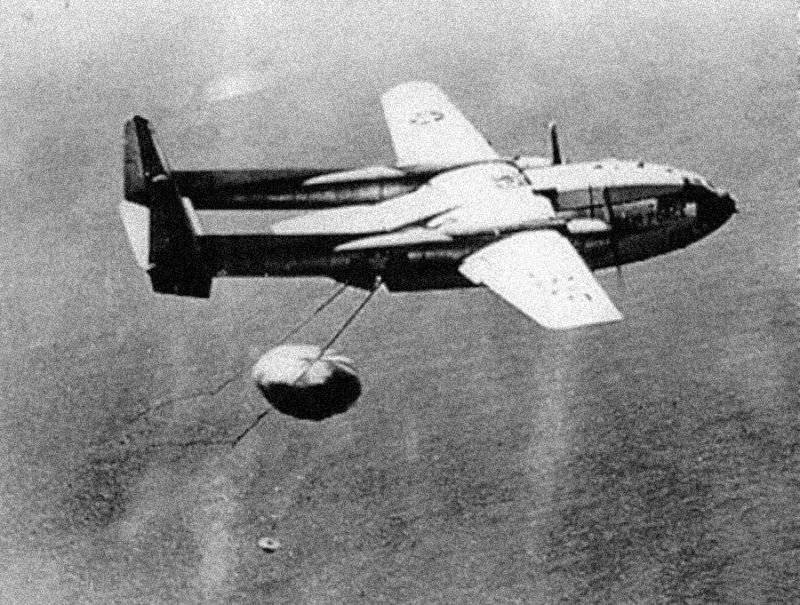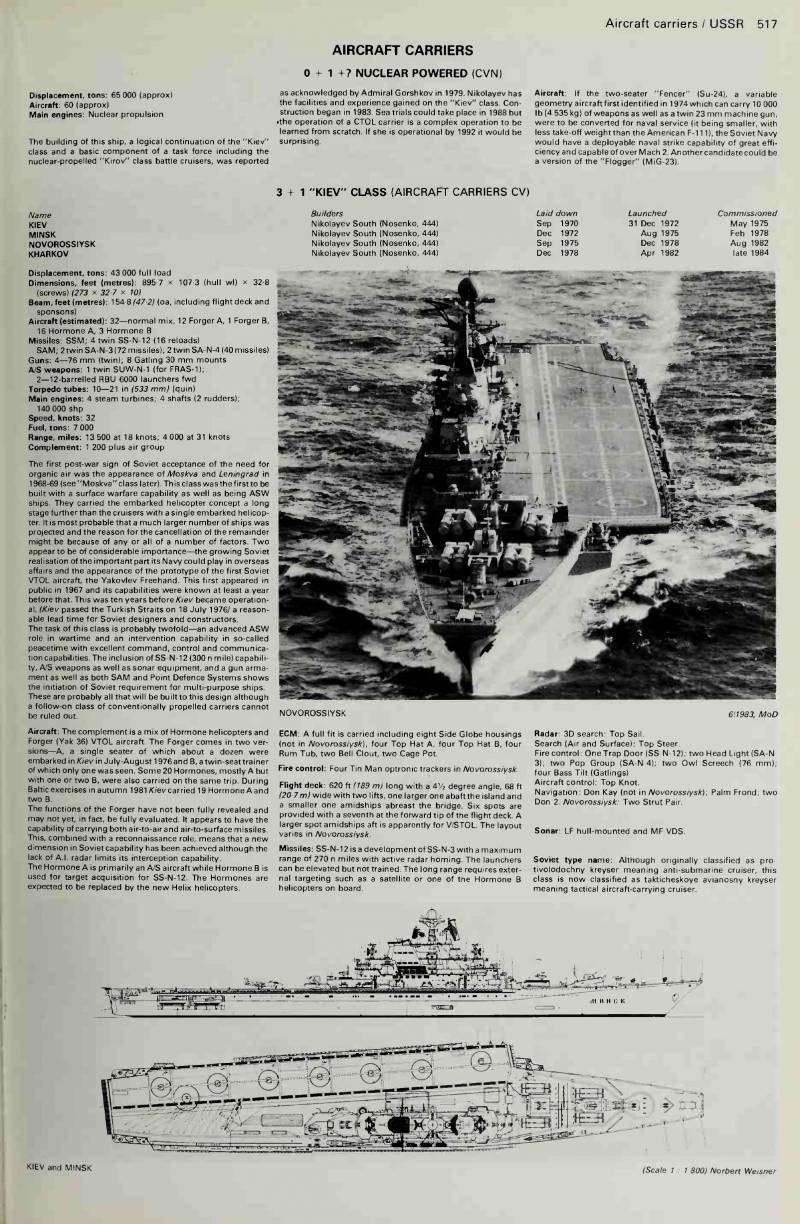Black Sea Shipyard: aircraft carriers and espionage

Western specialized publications, such as the famous British reference book, the annual Jane's Fighting Ships or the Soviet Military Power almanac, published on their pages sketches of promising aircraft-carrying Soviet ships and photographs of those already in the ranks. Technical and electronic intelligence by both sides of the confrontation was carried out on an ongoing basis, and "photo shoots" of the ships of the Navy of the USSR and the NATO countries were carried out mutually. Anti-submarine helicopters "Moscow" and "Leningrad", heavy anti-submarine cruisers of the 1143 project regularly appeared on the pages of specialized Western literature.
Of course, the Soviet side was well aware of the content of reference books, books and magazines published abroad, since this kind of literature was written and carefully studied. The Black Sea Shipyard had an extensive technical library, which also regularly received foreign publications. However, access to them was limited: it was believed that there was provided “secret” information.
This fact concealed a certain amount of absurdity: the information presented in foreign publications about Soviet ships, the development of military shipbuilding and its prospects in the USSR was of a completely open nature - in the West anyone could read it. Moreover, in the countries that are potential allies of the Soviet Union — Poland, Czechoslovakia, and the GDR — magazines and books devoted to various weapons, including Soviet weapons, were regularly published, indicating its tactical and technical characteristics.
In Nikolaev itself, where, despite its closed status, almost half of the population was somehow connected with the shipbuilding industry, they were well aware of which ships were being built at the Black Sea shipbuilding plant. The word "aircraft carrier" was extended at the household level, while at the official level, the official "heavy aircraft carrying cruiser" sounded. At meetings of the highest level, when the director of the Black Sea Plant, Yuri Ivanovich Makarov, called the ship being built at his factory, an "aircraft carrier", he was corrected every time.
Such an approach to secrecy according to the method of Monsieur Polichinel only discredited the attitude to real military and technological secrets. Therefore, when the era of friendship with the West came, simply streams of the most secret and truly valuable documentation poured in — not only because of outright treachery, but also because of the completely depreciated and careless attitude to their own wealth. Was it worth it, for example, with respect to planes adopted at the beginning of Khrushchev’s rule, to write faceless “multi-role fighter” in mass magazines so that in 90-s for all exchanges to pass on “sworn friends” all the documentation on promising Yak-141? All this will be later, but for now the Black Sea Shipbuilding Plant built aircraft carriers and its shore secrets.
At the beginning of the 1980's In the western editions (reference book “Jane's Fighting Ships” and the almanac “Soviet military power”) photographs appeared that captured the territory of the Black Sea plant with ships under construction and being completed. This caused some resonance in the Soviet leadership. During the next working visit to Moscow, the director of the enterprise, Yuri Ivanovich Makarov, was shown photos of the shipbuilding building and was asked to explain at what time interval they were taken - this could be determined by the position of sections and blocks. Makarov was an excellent specialist who was constantly on the stocks and could date the pictures almost to the day.

Since the images had good clarity and quality, those instances that followed should have a legitimate concern. In his book, The Aircraft Carrier, Yuri Ivanovich tells how some people in the State Security Committee suggested that photographs that did not get tired of typing and reprinting Western publications with a high flying airplane. Such an assumption seemed absurd: Nikolaev as an important concentration of industry of strategic importance, and as a city entering the first hundred targets for hitting nuclear weapons in the event of war, was well covered by anti-aircraft defense.
Specialists from the Academy of Sciences of the USSR were connected as experts in determining the “authorship” of the pictures. It was carried out painstaking research work. Knowing exactly the size of the huge 900-ton cranes over the “zero” slipway and their distortion in the photographs, the scientists determined that the two images under consideration were taken from the Odessa region and from the Kharkov region from a height of about 600 and 400 kilometers. Undoubtedly, the talk was about the use of spacecraft for reconnaissance purposes.
The idea of using spacecraft - satellites began to be widely discussed in the USA at the end of the 50s. The power of the Soviet air defense has increased significantly. Flights of reconnaissance aircraft, even such high-tech ones as the famous U-2, became unsafe, which was fully confirmed in the incident with the downed pilot Francis Gary Powers, whose U-2 was shot down in the Sverdlovsk 1 area in May 1960 of the year. This only increased attention to the program of developing a space reconnaissance satellite, which was launched on February 7 by President Dwight Eisenhower.
This program, the brainchild of the Central Intelligence Agency, was called the Crown (CORONA). It envisaged the creation and launch into Earth orbit of special spacecraft equipped with powerful cameras for conducting reconnaissance of objects in the territory of the USSR, the PRC and other countries, including even the formally allied United States Kuomintang Taiwan. The captured film in a special descent container was supposed to carry out a parachute landing.
The program, despite the attraction of significant resources, progressed heavily and intensely. The first 12 launches were unsuccessful for one reason or another. Only 18 August 1960, the first satellite of the program "Crown" was finally able to put into orbit. His flight lasted about a day, and then the descent capsule was intercepted by a special C-130 transport aircraft. If for some reason the plane could not complete its mission, the navy ship had to pick up the capsule. In order to avoid the danger of falling into the wrong hands, the capsules self-flooded over time.

The results of the first flight instilled genuine optimism into CIA specialists: the efficiency of the Korona satellite, which was named KN-1 (Keyhole - “keyhole”), turned out to be much more effective than the reconnaissance flight of the U-2 reconnaissance aircraft; or the threat of being shot down - an unsuccessful end of the pilot’s mission to power the project only.
Space espionage under the Crown program was carried out up to 1972. During this time, the reconnaissance photographic equipment made a significant leap in its development: if the resolution of the KH-1 camera was 8 – 12 meters, then similar characteristics of subsequent samples could be brought to 1,8 – 2,75 meters . Thanks to the “Crown” program, the intelligence and military bodies of the United States obtained crucial information, including the approximate number of intercontinental ballistic missiles available to the USSR. This information has allowed Americans to hold out a bit more confidently in the days of the Caribbean crisis.
The successes achieved by reconnaissance satellites, expectedly pushed the United States to further develop space reconnaissance programs in relation to the Soviet Union, China and other countries. A new project was launched, which received the code designation “Hexagon”, according to which it was planned to launch much more advanced technically satellites that could carry out shooting with 30 – 60 resolution, see
Before 1984, when the Hexagon program was completed, 18 satellites were launched. Unlike its predecessors, the new space reconnaissance aircraft did not require a descent capsule and a rather complicated procedure for its capture. Due to significant technical progress, 19 December 1976 was launched apparatus KH-11, equipped with an optical-electronic digital camera and capable of using electronic signals to transmit the footage to a communication satellite, which was located in a higher orbit, and in turn transmitted information to the ground.
Interested US agencies gained access to up-to-date intelligence in near real-time. The Crown and Hexagon programs were conducted in an atmosphere of heightened secrecy, but a complete curtain of secrecy was not achieved. Leaks began, and in the first place unauthorized. The first known occurred in the 1980 year. After the failed operation “Desert One” (Desert One) to free American diplomats who were taken hostage in Tehran, high-resolution images of the Iranian capital were found at the place of evacuation of American special forces fighters from the desert.
1984 was also rich in spy revelations. First, a photograph of a Soviet bomber standing at the airbase landed in the collection “Hearings in the US Congress”. Then the American expert and analyst of the Navy Samuel Loring Morison handed over to the publishing house of the famous Jane's Defense Weekly all the same KN-11 panoramic images of the high quality of the shipbuilding complex of the Black Sea Plant, where they could clearly see not only the huge KONE cranes of Finnish production, but also heavy aircraft carrying cruisers, which were under construction and completion From there, the pictures of ChSZ began to wander for various reference and specialized publications.
The publication of such materials has caused a resonance in the Soviet leadership and turmoil in the West. Morison was quickly put into circulation, incriminating him not only criminal negligence, but also the disclosure of secrets of state importance. In the 1985 year (when in the USSR the nature of an unexpected photo shoot ”which was built in the construction of the newest heavy aircraft carrier of the 11435 project had long been discovered), an expert analyst who decided to share photographic materials with publishers was sentenced to 5 years after the trial.
Pictures of the Black Sea plant were carried out from the board KH-11. The promulgation of images of the secret state program of space espionage caused a scandal in the relevant US authorities. However, at the trial against Morison, the public prosecutor was forced to swallow the fact that even before the publication of the pictures of the Black Sea Plant, the collection “Listening to cases in Congress” saw the light, where photographs of Soviet fighters appeared. At that time, the traditionally “tiny” defense budget was discussed, and the pictures of the aircraft of the recently proclaimed “Evil Empire” should have been in the hands of the right people to become an argument for additional funds.
The prosecution took into account such an annoying fact of leakage in the press of the US Congress - it was decided to assume that the photos were published "by mistake". The materials on the intelligence programs "Crown" and "Hexagon" were declassified only during the presidency of Bill Clinton in 1996.
The director of the Black Sea Plant, Yury Ivanovich Makarov, received not only open sources of popular science content, but also prepared and translated Western analysts. Abroad, we watched very closely the growth of the power of the Soviet Navy, considering that by the beginning of the 80s. he had achieved unprecedented military power and capabilities for continental Russia. The high technological equipment of shipyards and, in particular, the Black Sea Plant, was noted, where, thanks to the introduction of new techniques, high rates of ship building berths were achieved. And on the stocks number "0" meanwhile, the first Soviet classic aircraft carrier of the 1143.5 project was being built.
1143.5 aircraft carriers at CSY
By the beginning of the 1980's. The Black Sea Shipyard occupied one of the leading places in the shipbuilding industry of the Soviet Union. In the second half of 70, the company carried out a fundamental modernization of all its technological components. The capacity of the building complex has significantly expanded and increased due to the installation and installation of two 900-ton cranes of Finnish production. New workshops were created and substantially upgraded. At the plant a wide stream of new equipment went. A complete reconstruction of the existing moorings has been carried out and a new outbuilding embankment has been erected. The bottom is deep, and the corresponding communications are summed up.
The shipbuilding giant was ready to master the production of new warships - the heavy aircraft-carrying cruisers of the 1143.5 project, for the construction of which such modernization was carried out. The previous time, the Black Sea Plant underwent a similar large-scale procedure at the end of the 1930s, preparing for the construction of battleships of the 23 project.
To be continued ...

Information